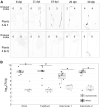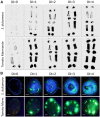The Bacterial Wilt Reservoir Host Solanum dulcamara Shows Resistance to Ralstonia solanacearum Infection
- PMID: 34868145
- PMCID: PMC8636001
- DOI: 10.3389/fpls.2021.755708
The Bacterial Wilt Reservoir Host Solanum dulcamara Shows Resistance to Ralstonia solanacearum Infection
Abstract
Ralstonia solanacearum causes bacterial wilt, a devastating plant disease, responsible for serious losses on many crop plants. R. solanacearum phylotype II-B1 strains have caused important outbreaks in temperate regions, where the pathogen has been identified inside asymptomatic bittersweet (Solanum dulcamara) plants near rivers and in potato fields. S. dulcamara is a perennial species described as a reservoir host where R. solanacearum can overwinter, but their interaction remains uncharacterised. In this study, we have systematically analysed R. solanacearum infection in S. dulcamara, dissecting the behaviour of this plant compared with susceptible hosts such as tomato cv. Marmande, for which the interaction is well described. Compared with susceptible tomatoes, S. dulcamara plants (i) show delayed symptomatology and bacterial progression, (ii) restrict bacterial movement inside and between xylem vessels, (iii) limit bacterial root colonisation, and (iv) show constitutively higher lignification in the stem. Taken together, these results demonstrate that S. dulcamara behaves as partially resistant to bacterial wilt, a property that is enhanced at lower temperatures. This study proves that tolerance (i.e., the capacity to reduce the negative effects of infection) is not required for a wild plant to act as a reservoir host. We propose that inherent resistance (impediment to colonisation) and a perennial habit enable bittersweet plants to behave as reservoirs for R. solanacearum.
Keywords: Ralstonia solanacearum; bacterial wilt; disease resistance; overwintering; reservoir host plants; vascular reinforcements.
Copyright © 2021 Sebastià, de Pedro-Jové, Daubech, Kashyap, Coll and Valls.
Conflict of interest statement
The authors declare that the research was conducted in the absence of any commercial or financial relationships that could be construed as a potential conflict of interest.
Figures





Similar articles
-
Strategies utilized by plants to defend against Ralstonia solanacearum.Front Plant Sci. 2025 May 26;16:1510177. doi: 10.3389/fpls.2025.1510177. eCollection 2025. Front Plant Sci. 2025. PMID: 40491817 Free PMC article. Review.
-
The in planta transcriptome of Ralstonia solanacearum: conserved physiological and virulence strategies during bacterial wilt of tomato.mBio. 2012 Aug 31;3(4):e00114-12. doi: 10.1128/mBio.00114-12. Print 2012. mBio. 2012. PMID: 22807564 Free PMC article.
-
Ralstonia solanacearum requires PopS, an ancient AvrE-family effector, for virulence and To overcome salicylic acid-mediated defenses during tomato pathogenesis.mBio. 2013 Nov 26;4(6):e00875-13. doi: 10.1128/mBio.00875-13. mBio. 2013. PMID: 24281716 Free PMC article.
-
Interspecific Potato Breeding Lines Display Differential Colonization Patterns and Induced Defense Responses after Ralstonia solanacearum Infection.Front Plant Sci. 2017 Aug 28;8:1424. doi: 10.3389/fpls.2017.01424. eCollection 2017. Front Plant Sci. 2017. PMID: 28894453 Free PMC article.
-
Ralstonia solanacearum, a widespread bacterial plant pathogen in the post-genomic era.Mol Plant Pathol. 2013 Sep;14(7):651-62. doi: 10.1111/mpp.12038. Epub 2013 May 30. Mol Plant Pathol. 2013. PMID: 23718203 Free PMC article. Review.
Cited by
-
Assembly and annotation of Solanum dulcamara and Solanum nigrum plant genomes, two nightshades with contrasting susceptibilities to Ralstonia solanacearum.G3 (Bethesda). 2025 Jul 9;15(7):jkaf119. doi: 10.1093/g3journal/jkaf119. G3 (Bethesda). 2025. PMID: 40418738 Free PMC article.
-
Biofilm-Forming Ability of Phytopathogenic Bacteria: A Review of its Involvement in Plant Stress.Plants (Basel). 2023 Jun 3;12(11):2207. doi: 10.3390/plants12112207. Plants (Basel). 2023. PMID: 37299186 Free PMC article. Review.
-
Naringenin restricts the colonization and growth of Ralstonia solanacearum in tobacco mutant KCB-1.Plant Physiol. 2024 Jun 28;195(3):1818-1834. doi: 10.1093/plphys/kiae185. Plant Physiol. 2024. PMID: 38573326 Free PMC article.
-
Strategies utilized by plants to defend against Ralstonia solanacearum.Front Plant Sci. 2025 May 26;16:1510177. doi: 10.3389/fpls.2025.1510177. eCollection 2025. Front Plant Sci. 2025. PMID: 40491817 Free PMC article. Review.
-
Tomato-Thaumatin-like Protein Genes Solyc08g080660 and Solyc08g080670 Confer Resistance to Five Soil-Borne Diseases by Enhancing β-1,3-Glucanase Activity.Genes (Basel). 2023 Aug 14;14(8):1622. doi: 10.3390/genes14081622. Genes (Basel). 2023. PMID: 37628673 Free PMC article.
References
-
- Caldwell D. (2016). The Role of Root Anatomy and Root Architecture in Resistance to Ralstonia solanacearum. Ph. D. thesis. West Lafayette: Purdue University.

